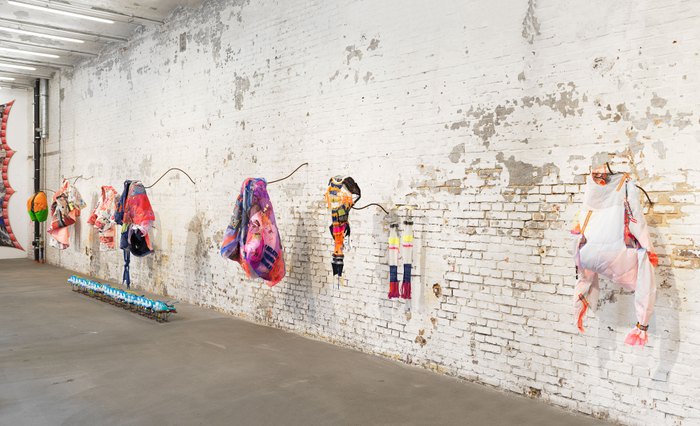The works of Berlin-based artist Susi Hinz (b. 1988, Germany) are momentary snapshots of a process in constant evolution. Hinz trained in fashion at the Weissensee Academy of Art Berlin and immediately diverged from the world of commercial fashion, creating wearable sculptures meant to take part in performative actions. An outsider to both the worlds of fashion and contemporary art, Hinz is an artist who has created her own logic; her unique working method bridges assemblage, couture, and cultural critique, investigating the complex dynamic between the body and the world around it.
This exhibition at Callie’s marks the artist’s first solo show to date. Hinz has transformed the space into a collage of early and recent works, including her iconic wearable sculptures, as well as drawings, videos, an audio installation, and her “system models”—sculptures assembled from everyday materials. These playful constructions mark a crucial initial step in the artist’s creative process—akin to sketching in three dimensions. To make the system models, Hinz examines her surroundings with great attention to detail, creating delicate and complex arrangements using the found materials she collects. In doing so, Hinz questions our present moment through its objects, building micro-worlds in order to make sense of the larger one in which we live.
During her seven-month residency at Callie’s, Hinz worked in a new format, developing the monumental artist’s book Das Armgehirn des Nochmensch (“The Arm-Brain of the Still-Human”, 2020), a condensation of images of past works, photos culled from the Internet, original drawings, and poems. The book sits at the center of the room on a skeletal iron pedestal that literally expands into the space, enveloping colored tubes which resemble blood vessels or underground urban infrastructure. Hinz uses overlays and entanglements to invoke earlier work while creating a starting point for new questions. An expanse of printed elastane protrudes from the far end of the exhibition and draws the viewer into a whirlpool of images, while the wall of vacuum-packed phones and tablets suggests Hinz’s critical examination of visual consumption.





